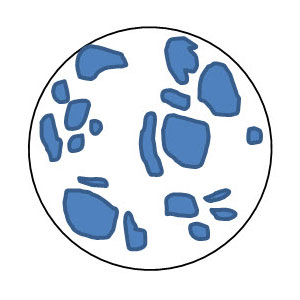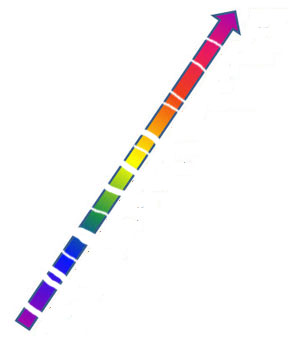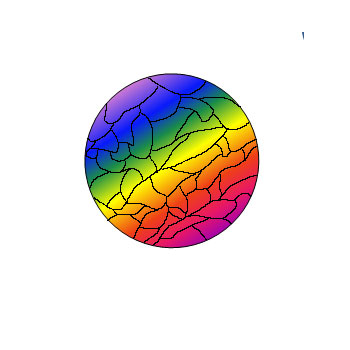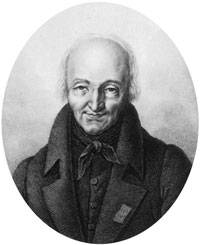|
9 - Diatoms:
carved at the joints Candolle was involved not only in naming plants but also in building the theoretical foundations and methods to classify them, to arrange them so as to accurately represent the reality of their natural relations. Nothing is more fundamental to this endeavor than clarity in what-it-is-that-is-being-classified. Figure 33 (below, left) A representation of Charles Bonnet's (1764) Scale of Nature [= Chain of Being], largely adapted from Bowler (1984), showing the expected pattern of nature; (right) the Scale showing regions for which no representative kinds of beings had been discovered at the time (transverse white areas on the arrow), or, "gaps in knowledge."
Figure
34 (below. left). A schematic representation of Linnaeus' model of the
fully revealed face of nature. The color gradient is extremely simplified
and meant to merely represent a continuum of kinds or organisms, not
necessarily a linear one; the black lines are arbitrarily delimited
chunks of the continuum treated as genera or other taxa; (right)
a schematic representation of the Linnaean model in practice: the white
areas repesent "gaps in knowledge", forms of organsims expected
but not yet found.
Figure 35 (below). A schematic representation of Candolle's model of the face of nature: colored patches are discrete groups of organisms of the same kind; the white region represents conceivable forms for which no actual kinds exist or have never existed (In current terminology the white area might be called "empty morphospace".).  Candolle rejected the idea of a scale of nature as just "poetic scaffolding". In addition to a variety of philosophical problems with it, the scala just did not match his own experiences with nature or those of many other botanists. The experiences of centuries of naturalists had failed to substantially fill its gaps. Candolle took all this continuity of kinds, this spectrum of integrading variants with which the face of nature had been supposedly painted, and instead saw a quantized face (Figure 35). To borrow Candolle's own metaphor, where Linnaeus saw a continental continuum of variants arbitrarily subdivided, Candolle saw an archipelago - islands representing species of variable organisms more similar to one another than to those constituting other islands -- islands separated at varying distances from one another by the sea, his metaphorical equivalent of real quantifiable gaps in the spectrum of the kinds which actually existed - islands assembled in hierarchical clusters. Gaps were not necessarily the result of ignorance, they often represented real voids in the fabric of nature; nature was not all plentiful. And it was these gaps among groups that provided the means of getting at the kinds of things in nature to be classified; gaps, even though varying in breadth, were the sutures which marked the discrete divisions of the natural world unequally into groups. To Candolle, to define and name a group was thus a discovery, not an invention -- the group was already out there. As early as 1802 in reviewing the genus Conferva and other algal genera, he would write "..., je tracerai les divisions génériques que la nature me semble y avoir établies, ...." [..., I will trace the divisions of genera that, it seems to me, nature has established."] So, in the early nineteenth century he and Cuvier and others redirected the research program of natural history from trying to fill unfillable gaps in a scala naturae to trying to discover gaps as justification for recognizing groups. From then to this day biologists (diatomists included) in claiming to have found some new species are invariably hit with the question "Where is the gap?" We legislate in our rules for recognizing and naming new species "Show me the diagnosis" -- the statement of how this new species is discontinuous in some discrete or continuous pattern of its variation from species most similar to it. While there is much to remark upon in Candolle's voluminous and rich works, his advocating a discontinuous view of the structure of organic nature, one in which nature is already divided up into groups, one clearly in contrast with the scala naturae, and his goal of securing a natural classification by division -- by the repeated separation of the whole of nature into groups subordinate to groups -- particularly resonate with me, because of the conjunction of the word diatom, the word he chose for our group of microbes, with these ideas in Platonic philosophy, whether he realized this conjunction or not. The tension between analysis and synthesis was fundamental in Candolle's consideration of the theory and practice of classification, as it was to other botanists of the day. Analysis, in particular, was the more preferable route to natural classification, although he saw it as operationally the more problematic of the two roads. His consideration of these approaches to classification continued philosophical discussions born under the plane trees of Athens 2000 years before. Socrates in Plato's Phaedrus conducts a search for love, a pursuit of its true meaning by means of a dialectic, of a critical reasoned discussion employing two contrasting approaches: one, synthesis, "the comprehension of scattered particulars in one idea" -- Candolle's "le marche d'invention" -- the other, analysis -- Candolle's "le marche de la vérification." When Phaedrus asks Socrates to explain this latter approach, this "analysis", he responds:
Figure
35. Plato's Phaedrus. Section 265e.
Dividing where the joint is -- that's cleavage! This well-known "Bad Carver" metaphor uses diatemnein (circled in red in the Greek above), the word harboring the Greek roots of diatomes, not just to describe the act of cutting or division but rather a careful cutting, a division along the natural sutures. There are places to cut and not to cut in the Socratic pursuit of what is real and true and good, in the pursuit of universals -- in the pursuit of the unit cells of crystals, in the pursuit of the discrete groups of organisms that populate the world and their relationships. When Candolle urged botanists to abandon the scale of nature, he was proclaiming that nature did indeed have joints. And that if you were going classify the units of nature, in getting at those units and their relations do not splinter nature, but divide (read carve) it along its natural joints. But this "analysis" was also, I think, from a largely observational perspective what he likely perceived -- with a mind prepared by Haüy -- in the zig-zag conferva-like filaments when he aptly christened them diatomes -- carved at the joints.
Figure
36 (left).
Augustin Pyrame de Candolle (1778-1841). Image: Galerie des Naturalistes,
J. Pizzetta, Ed, Hennuyer, 1893. Image: Public Domain. |
| <-- 8 - Louriero's Diatoma - |

Creative
Commons Attribution-NonCommercial-NoDerivs 3.0 Unported License

 Long
before and throughout the 18th century, views of the organic world were
dominated by the concept of a scale of nature (scala naturae in
Latin) -- a vector of the kinds of inorganic and organic beings, one
grading continuously into the next, one higher and one lower, on a linear
scale of complexity and perfection, projecting into the heavens (Figure
33). Representatives of many parts of this imagined scale were known
by the 18th century, but for other parts representatives remained undiscovered
- missing links, leaving gaps in knowldege of the scale. A major task
of the reverent naturalist of the day was to fill in the gaps by studying
nature and thus reveal new kinds which fit, as both philosophical tradition
and theological principles assured could be done.
Long
before and throughout the 18th century, views of the organic world were
dominated by the concept of a scale of nature (scala naturae in
Latin) -- a vector of the kinds of inorganic and organic beings, one
grading continuously into the next, one higher and one lower, on a linear
scale of complexity and perfection, projecting into the heavens (Figure
33). Representatives of many parts of this imagined scale were known
by the 18th century, but for other parts representatives remained undiscovered
- missing links, leaving gaps in knowldege of the scale. A major task
of the reverent naturalist of the day was to fill in the gaps by studying
nature and thus reveal new kinds which fit, as both philosophical tradition
and theological principles assured could be done. 
 Linnaeus
and others largely saw this same continuity among kinds in the natural
world but viewed it more two-dimensionally, as countries on a map --
a continuous landscape of variants, but which were still grouped arbitrarily
and given artificial boundaries (Figure 34) by man. Gaps on the map
were still gaps in knowledge -- "Nature does not make jumps"
(In Latin: Natura non facit saltus.) was a Linnaean touchstone.
Continued revelation was expected to ultimately make plenitude manifest.
Linnaeus
and others largely saw this same continuity among kinds in the natural
world but viewed it more two-dimensionally, as countries on a map --
a continuous landscape of variants, but which were still grouped arbitrarily
and given artificial boundaries (Figure 34) by man. Gaps on the map
were still gaps in knowledge -- "Nature does not make jumps"
(In Latin: Natura non facit saltus.) was a Linnaean touchstone.
Continued revelation was expected to ultimately make plenitude manifest.


